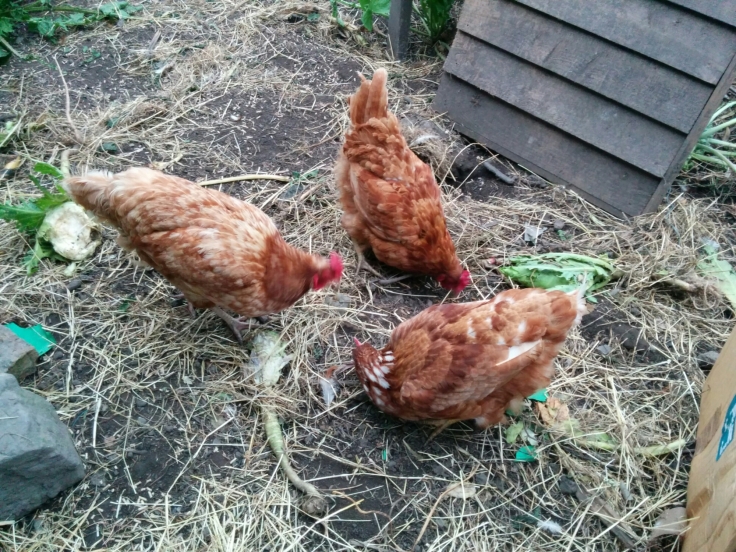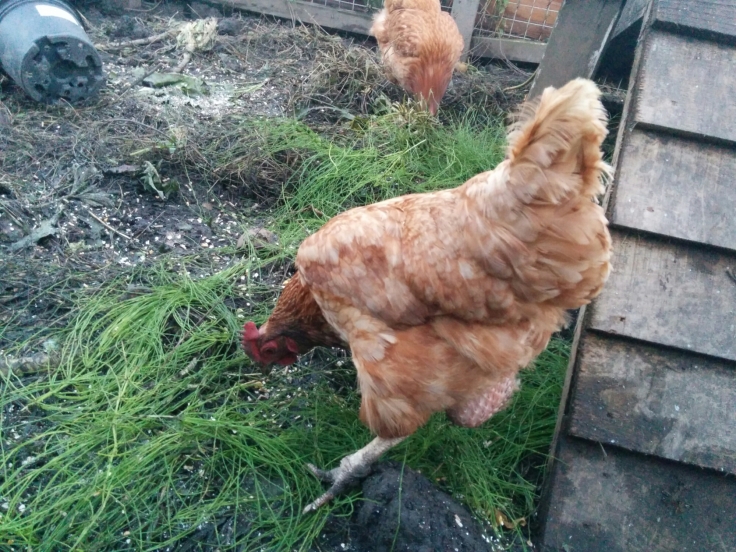Keeping chickens is increasingly common, with many people looking to have fresh eggs every day with the bonus of having new pets that can happily live in the back garden or allotment.
There are many different breeds of chickens ranging from pure breeds who lay less eggs, to hybrids which can lay over 300 eggs a year. Our flock of chickens currently comprises a Bluebell (produces the olive eggs) named Flora, two Cream Legbars (Polly and Rey) who lay greenish eggs, a Black Rock (Dora), a silver-pencilled Plymouth Rock (Leia – born on Star Wars day!), an Araucana (Sadie who layes green eggs), a Swedish Flower Hen (Lilja who has the world’s longest legs for escaping!), a Light Sussex (Alba), a Rhode Island Red (our cockerel Tommy). We have previously had more Warrens (Lottie, Betty, Annie, Masie, Doris, Evie, Katie and Georgie, Hattie), Black Rocks (Squeak, Snap, Fizz, Pop and Crackle), Cuckoo Marans (Nelly and Daisy), Rhode Island Reds (Aggie and Cassie) and a hybrid breed called Nova (Maggie and Peggie) as well as two Vorwerks (Holly and Molly)
One of our warrens
Our speckled white chicken (Emily)
One of our Nova’s (Maggie)

One of our Vorwerks (Molly)

One of our Cream Legbars (Dolly)

Our Cuckoo marans, Nelly and Daisy

One of our Black Rocks (Squeak)
More recently, we have rescued and hatched some bantams. These are hens, just smaller! The Bantam’s fearless leader is Roxy, a Speckled Sussex who was left abandoned at the allotment gate during lockdown. She was swiftly joined by Trixy (a Silver Birchen) and Foxy (Porcelain Millie Fleur). When Trixy went broody in the summer of 2021, she hatched five chicks (two Millie Fleur and three Partridge bantams). Gordon and his gang of girls live at the allotment in the New Coop.
At home, we have several more chickens. Two we call the Ancient Ones as Maude and Mavis must be at least eight years old. They are utterly inseparable and live a quiet life in their retirement coop. At the other end of the garden, we have our three silkies. Cirrus, Nimbus and Stratus joined us in late 2020 and spend their time bumbling around the garden terrorising passing cats.
Although chickens can get all the nutrients they need from layers pellets, they do enjoy a range of other foods. We feed ours porridge oats, sunflower seeds, split corn and occasionally a slice of brown bread or meal worms as a treat. They also require greens, usually in the form of grass or weeds (often in abundant supply from spring to summer), or if you are feeling flush, lettuce or spinach bought from the shop (we resort to this in the winter).
Along with pellets, they must always have access to grit and fresh water. The fresh water speaks for itself. This should be changed every day, you may want to put in a small amount of cider vinegar as this helps kill off any nasties in their digestive system. The need for grit only becomes apparent when you get an egg that looks like this….
Basically chickens use the grit not only to grid down food in the stomach but as an essential requirement to make the egg shell. Give the chickens grit either in their food or put it out in a pot for them to go to when they know they need it.
Some people keep their chickens for 2-3 years before moving them on as they wish to keep egg production high. We have taken a slightly different approach, expanding our flock to include younger birds who will keep up egg production whilst the older chickens wind down. Plus it seems a little ungrateful to move them on the second they stop laying as often as you wish. We are known as a retirement home for chickens! Of course, whether you rotate your flock or keep them depends on whether you keep chickens for the eggs or as pets with the added bonus of eggs.
Keep a close eye on their nest box and bedding as these areas can easily harbour mites. These mites multiply rapidly, preferring to live on the chickens, weakening their immune system until they die. Regularly pick up each chicken and check under the wing in the triangular area between wing and body. If you find mites, remove them before using a generous amount of diatumous earth in the area, rubbing it into the skin and on the feathers. Once each chicken has been dusted, remove all bedding from the nest box and proceed to spray the area (ensuring all chickens are kept away and that you are in a well ventilated area) with anti-mite spray. Dowse the nest box thoroughly and leave it to dry for at least half an hour. When the nest box is dry, place diatumous earth on the base of the box before adding in the new bedding and putting a final sprinkle of diatumous earth on the top. Keep a very close eye on the chickens and the coop over the next few days to make sure the mite population is decreasing or has been eliminated.
Several years ago, we suffered with a massive mite infestation. We spent days repeatedly dowsing chickens and the shed alike to try to make a dent in the mite numbers. It took over a week, three bottles of diatumous earth and 4 cans of anti-mite spray but we finally got on top of it!










Leave a comment